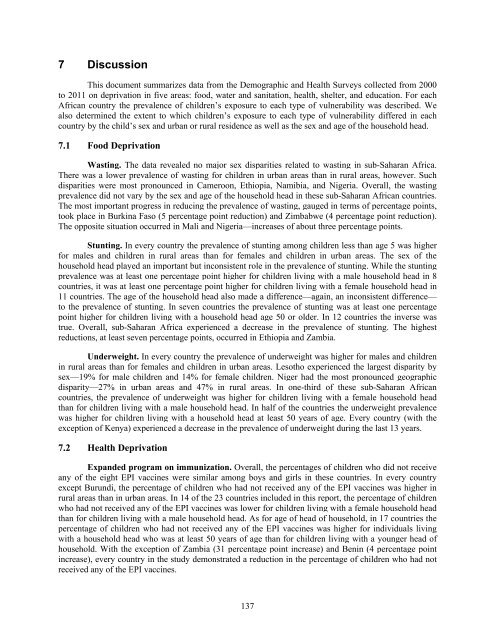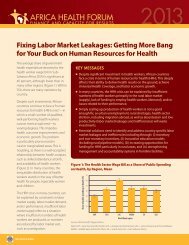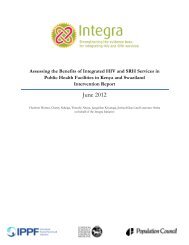ujh78
ujh78
ujh78
Create successful ePaper yourself
Turn your PDF publications into a flip-book with our unique Google optimized e-Paper software.
7 Discussion<br />
This document summarizes data from the Demographic and Health Surveys collected from 2000<br />
to 2011 on deprivation in five areas: food, water and sanitation, health, shelter, and education. For each<br />
African country the prevalence of children’s exposure to each type of vulnerability was described. We<br />
also determined the extent to which children’s exposure to each type of vulnerability differed in each<br />
country by the child’s sex and urban or rural residence as well as the sex and age of the household head.<br />
7.1 Food Deprivation<br />
Wasting. The data revealed no major sex disparities related to wasting in sub-Saharan Africa.<br />
There was a lower prevalence of wasting for children in urban areas than in rural areas, however. Such<br />
disparities were most pronounced in Cameroon, Ethiopia, Namibia, and Nigeria. Overall, the wasting<br />
prevalence did not vary by the sex and age of the household head in these sub-Saharan African countries.<br />
The most important progress in reducing the prevalence of wasting, gauged in terms of percentage points,<br />
took place in Burkina Faso (5 percentage point reduction) and Zimbabwe (4 percentage point reduction).<br />
The opposite situation occurred in Mali and Nigeria—increases of about three percentage points.<br />
Stunting. In every country the prevalence of stunting among children less than age 5 was higher<br />
for males and children in rural areas than for females and children in urban areas. The sex of the<br />
household head played an important but inconsistent role in the prevalence of stunting. While the stunting<br />
prevalence was at least one percentage point higher for children living with a male household head in 8<br />
countries, it was at least one percentage point higher for children living with a female household head in<br />
11 countries. The age of the household head also made a difference—again, an inconsistent difference—<br />
to the prevalence of stunting. In seven countries the prevalence of stunting was at least one percentage<br />
point higher for children living with a household head age 50 or older. In 12 countries the inverse was<br />
true. Overall, sub-Saharan Africa experienced a decrease in the prevalence of stunting. The highest<br />
reductions, at least seven percentage points, occurred in Ethiopia and Zambia.<br />
Underweight. In every country the prevalence of underweight was higher for males and children<br />
in rural areas than for females and children in urban areas. Lesotho experienced the largest disparity by<br />
sex—19% for male children and 14% for female children. Niger had the most pronounced geographic<br />
disparity—27% in urban areas and 47% in rural areas. In one-third of these sub-Saharan African<br />
countries, the prevalence of underweight was higher for children living with a female household head<br />
than for children living with a male household head. In half of the countries the underweight prevalence<br />
was higher for children living with a household head at least 50 years of age. Every country (with the<br />
exception of Kenya) experienced a decrease in the prevalence of underweight during the last 13 years.<br />
7.2 Health Deprivation<br />
Expanded program on immunization. Overall, the percentages of children who did not receive<br />
any of the eight EPI vaccines were similar among boys and girls in these countries. In every country<br />
except Burundi, the percentage of children who had not received any of the EPI vaccines was higher in<br />
rural areas than in urban areas. In 14 of the 23 countries included in this report, the percentage of children<br />
who had not received any of the EPI vaccines was lower for children living with a female household head<br />
than for children living with a male household head. As for age of head of household, in 17 countries the<br />
percentage of children who had not received any of the EPI vaccines was higher for individuals living<br />
with a household head who was at least 50 years of age than for children living with a younger head of<br />
household. With the exception of Zambia (31 percentage point increase) and Benin (4 percentage point<br />
increase), every country in the study demonstrated a reduction in the percentage of children who had not<br />
received any of the EPI vaccines.<br />
137








